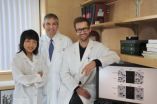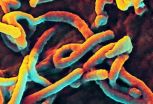(Press-News.org) Depictions of animals in ancient Egyptian artifacts have helped scientists assemble a detailed record of the large mammals that lived in the Nile Valley over the past 6,000 years. A new analysis of this record shows that species extinctions, probably caused by a drying climate and growing human population in the region, have made the ecosystem progressively less stable.
The study, published September 8 in Proceedings of the National Academy of Sciences (PNAS), found that local extinctions of mammal species led to a steady decline in the stability of the animal communities in the Nile Valley. When there were many species in the community, the loss of any one species had relatively little impact on the functioning of the ecosystem, whereas it is now much more sensitive to perturbations, according to first author Justin Yeakel, who worked on the study as a graduate student at the University of California, Santa Cruz, and is now a postdoctoral fellow at the Santa Fe Institute.
Around six millennia ago, there were 37 species of large-bodied mammals in Egypt, but only eight species remain today. Among the species recorded in artwork from the late Predynastic Period (before 3100 BC) but no longer found in Egypt are lions, wild dogs, elephants, oryx, hartebeest, and giraffe.
"What was once a rich and diverse mammalian community is very different now," Yeakel said. "As the number of species declined, one of the primary things that was lost was the ecological redundancy of the system. There were multiple species of gazelles and other small herbivores, which are important because so many different predators prey on them. When there are fewer of those small herbivores, the loss of any one species has a much greater effect on the stability of the system and can lead to additional extinctions."
The new study is based on records compiled by zoologist Dale Osborne, whose 1998 book The Mammals of Ancient Egypt provides a detailed picture of the region's historical animal communities based on archaeological and paleontological evidence as well as historical records. "Dale Osborne compiled an incredible database of when species were represented in artwork and how that changed over time. His work allowed us to use ecological modeling techniques to look at the ramifications of those changes," Yeakel said.
The study had its origins in 2010, when Yeakel visited a Tutankhamun exhibition in San Francisco with coauthor Nathaniel Dominy, then an anthropology professor at UC Santa Cruz and now at Dartmouth. "We were amazed at the artwork and the depictions of animals, and we realized they were recording observations of the natural world. Nate was aware of Dale Osborne's book, and we started thinking about how we could take advantage of those records," Yeakel said.
Coauthor Paul Koch, a UCSC paleontologist who studies ancient ecosystems, helped formulate the team's approach to using the records to look at the ecological ramifications of the changes in species occurrences. Yeakel teamed up with ecological modelers Mathias Pires of the University of Sao Paolo, Brazil, and Lars Rudolf of the University of Bristol, U.K., to do a computational analysis of the dynamics of predator-prey networks in the ancient Egyptian animal communities.
The researchers identified five episodes over the past 6,000 years when dramatic changes occurred in Egypt's mammalian community, three of which coincided with extreme environmental changes as the climate shifted to more arid conditions. These drying periods also coincided with upheaval in human societies, such as the collapse of the Old Kingdom around 4,000 years ago and the fall of the New Kingdom about 3,000 years ago.
"There were three large pulses of aridification as Egypt went from a wetter to a drier climate, starting with the end of the African Humid Period 5,500 years ago when the monsoons shifted to the south," Yeakel said. "At the same time, human population densities were increasing, and competition for space along the Nile Valley would have had a large impact on animal populations."
The most recent major shift in mammalian communities occurred about 100 years ago. The analysis of predator-prey networks showed that species extinctions in the past 150 years had a disproportionately large impact on ecosystem stability. These findings have implications for understanding modern ecosystems, Yeakel said.
"This may be just one example of a larger pattern," he said. "We see a lot of ecosystems today in which a change in one species produces a big shift in how the ecosystem functions, and that might be a modern phenomenon. We don't tend to think about what the system was like 10,000 years ago, when there might have been greater redundancy in the community."
INFORMATION:
In addition to Yeakel, Pires, Rudolf, Dominy, and Koch, the coauthors of the paper include Thilo Gross at the University of Bristol and Paulo Guimaraes at the University of Sao Paolo. This work was funded by the National Science Foundation and the Sao Paolo Research Foundation.
Study traces ecological collapse over 6,000 years of Egyptian history
Ancient Egyptian artworks help scientists reconstruct how animal communities changed as climate became drier and human populations grew
2014-09-08
ELSE PRESS RELEASES FROM THIS DATE:
Broken signals lead to neurodegeneration
2014-09-08
Researchers from the RIKEN Brain Science Institute in Japan, in collaboration with Juntendo University and the Japan Science and Technology Agency, have discovered that a cell receptor widely involved in intracellular calcium signaling--the IP3R receptor--can be locked into a closed state by enzyme action, and that this locking may potentially play a role in the reduction of neuron signaling seen in neurodegenerative diseases such as Huntington's and Alzheimer's disease.
In the research published today in the Proceedings of the National Academy of Sciences, the scientists ...
In directing stem cells, study shows context matters
2014-09-08
MADISON, Wis. — Figuring out how blank slate stem cells decide which kind of cell they want to be when they grow up — a muscle cell, a bone cell, a neuron — has been no small task for science.
Human pluripotent stem cells, the undifferentiated cells that have the potential to become any of the 220 types of cells in the body, are influenced in the lab dish by the cocktail of chemical factors and proteins upon which they are grown and nurtured. Depending on the combination of factors used in a culture, the cells can be coaxed to become specific types of cells.
Now, in ...
Co-flowing liquids can stabilize chaotic 'whipping' in microfluidic jets
2014-09-08
VIDEO:
This video show jets emerging from the same glass needle in chaotic whipping (left) and a steady state helical whipping. By controlling the viscosity and speed of the liquid surrounding...
Click here for more information.
Industrial wet spinning processes produce fibers from polymers and other materials by using tiny needles to eject continuous jets of liquid precursors. The electrically charged liquids ejected from the needles normally exhibit a chaotic "whipping" structure ...
Brain injuries no match for sPIF treatment
2014-09-08
New Haven, Conn. — Researchers at Yale School of Medicine and their colleagues have uncovered a new pathway to help treat perinatal brain injuries. This research could also lead to treatments for traumatic brain injuries and neurodegenerative disorders such as Alzheimer’s and Parkinson’s.
The findings are published in the Sept. 8 issue of Proceedings of the National Academy of Sciences.
The microRNA let-7 is known to cause the death of neurons in the central nervous system. The research team found that a synthetic molecule derived from the embryo called PreImplantation ...
Textbook theory behind volcanoes may be wrong
2014-09-08
In the typical textbook picture, volcanoes, such as those that are forming the Hawaiian islands, erupt when magma gushes out as narrow jets from deep inside Earth. But that picture is wrong, according to a new study from researchers at Caltech and the University of Miami in Florida.
New seismology data are now confirming that such narrow jets don't actually exist, says Don Anderson, the Eleanor and John R. McMillian Professor of Geophysics, Emeritus, at Caltech. In fact, he adds, basic physics doesn't support the presence of these jets, called mantle plumes, and the ...
UCLA biologists delay the aging process by 'remote control'
2014-09-08
UCLA biologists have identified a gene that can slow the aging process throughout the entire body when activated remotely in key organ systems.
Working with fruit flies, the life scientists activated a gene called AMPK that is a key energy sensor in cells; it gets activated when cellular energy levels are low.
Increasing the amount of AMPK in fruit flies' intestines increased their lifespans by about 30 percent — to roughly eight weeks from the typical six — and the flies stayed healthier longer as well.
The research, published Sept. 4 in the open-source journal Cell ...
Rapid and durable protection against ebola virus with new vaccine regimens
2014-09-08
One shot of an experimental vaccine made from two Ebola virus gene segments incorporated into a chimpanzee cold virus vector (called chimp adenovirus type 3 or ChAd3) protected all four macaque monkeys exposed to high levels of Ebola virus 5 weeks after inoculation, report National Institutes of Health (NIH) scientists and their collaborators. The ability of the ChAd3 Ebola virus vaccine to elicit rapid protection in monkeys is notable as the world health community battles an ongoing Ebola virus disease outbreak in West Africa. While the protective effects of the single ...
Teens living with 2 college-educated parents less likely to use alcohol and marijuana
2014-09-08
ARLINGTON, Texas -- A high school senior who lives with two college-educated parents is significantly less likely to drink alcohol or smoke marijuana than a teenager who lives with one parent, a new University of Texas at Arlington study has found.
For example, teens living with their mother only are 54 percent more likely to use alcohol, and 58 percent more likely to smoke if they live only with their father.
Eusebius Small, an assistant professor in the UT Arlington School of Social Work, analyzed data on 14,268 teenagers to determine the impact of family structure ...
Ohio University paleontologists discover new species of titanosaurian dinosaur in Tanzania
2014-09-08
ATHENS, Ohio (Sept. 8, 2014)—Ohio University paleontologists have identified a new species of titanosaurian, a member of the large-bodied sauropods that thrived during the final period of the dinosaur age, in Tanzania. Although many fossils of titanosaurians have been discovered around the globe, especially in South America, few have been recovered from the continent of Africa.
The new species, named Rukwatitan bisepultus, was first spotted by scientists embedded in a cliff wall in the Rukwa Rift Basin of southwestern Tanzania. Using the help of professional excavators ...
In one of nature's innovations, a single cell smashes and rebuilds its own genome
2014-09-08
Life can be so intricate and novel that even a single cell can pack a few surprises, according to a study led by Princeton University researchers.
The pond-dwelling, single-celled organism Oxytricha trifallax has the remarkable ability to break its own DNA into nearly a quarter-million pieces and rapidly reassemble those pieces when it's time to mate, the researchers report in the journal Cell. The organism internally stores its genome as thousands of scrambled, encrypted gene pieces. Upon mating with another of its kind, the organism rummages through these jumbled genes ...
LAST 30 PRESS RELEASES:
Tracing the quick synthesis of an industrially important catalyst
New software sheds light on cancer’s hidden genetic networks
UT Health San Antonio awarded $3 million in CPRIT grants to bolster cancer research and prevention efforts in South Texas
Third symposium spotlights global challenge of new contaminants in China’s fight against pollution
From straw to soil harmony: International team reveals how biochar supercharges carbon-smart farming
Myeloma: How AI is redrawing the map of cancer care
Manhattan E. Charurat, Ph.D., MHS invested as the Homer and Martha Gudelsky Distinguished Professor in Medicine at the University of Maryland School of Medicine
Insilico Medicine’s Pharma.AI Q4 Winter Launch Recap: Revolutionizing drug discovery with cutting-edge AI innovations, accelerating the path to pharmaceutical superintelligence
Nanoplastics have diet-dependent impacts on digestive system health
Brain neuron death occurs throughout life and increases with age, a natural human protein drug may halt neuron death in Alzheimer’s disease
SPIE and CLP announce the recipients of the 2025 Advanced Photonics Young Innovator Award
Lessons from the Caldor Fire’s Christmas Valley ‘Miracle’
Ant societies rose by trading individual protection for collective power
Research reveals how ancient viral DNA shapes early embryonic development
A molecular gatekeeper that controls protein synthesis
New ‘cloaking device’ concept to shield sensitive tech from magnetic fields
Researchers show impact of mountain building and climate change on alpine biodiversity
Study models the transition from Neanderthals to modern humans in Europe
University of Phoenix College of Doctoral Studies releases white paper on AI-driven skilling to reduce burnout and restore worker autonomy
AIs fail at the game of visual “telephone”
The levers for a sustainable food system
Potential changes in US homelessness by ending federal support for housing first programs
Vulnerability of large language models to prompt injection when providing medical advice
Researchers develop new system for high-energy-density, long-life, multi-electron transfer bromine-based flow batteries
Ending federal support for housing first programs could increase U.S. homelessness by 5% in one year, new JAMA study finds
New research uncovers molecular ‘safety switch’ shielding cancers from immune attack
Bacteria resisting viral infection can still sink carbon to ocean floor
Younger biological age may increase depression risk in older women during COVID-19
Bharat Innovates 2026 National Basecamp Showcases India’s Most Promising Deep-Tech Ventures
Here’s what determines whether your income level rises or falls
[Press-News.org] Study traces ecological collapse over 6,000 years of Egyptian historyAncient Egyptian artworks help scientists reconstruct how animal communities changed as climate became drier and human populations grew






